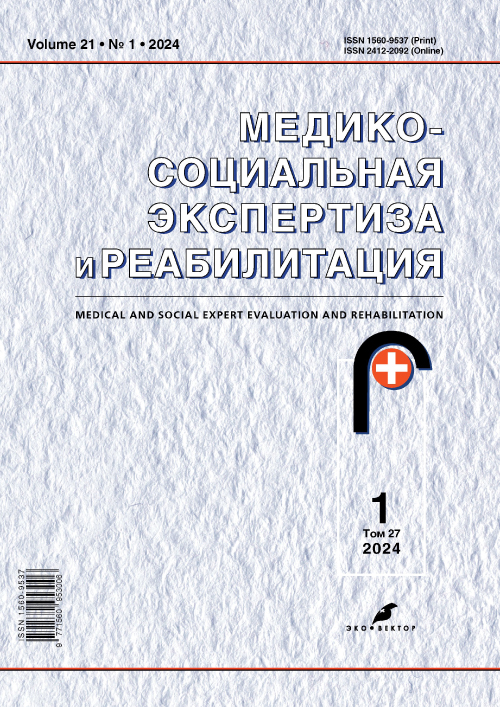Characteristics and nosological structure of recurrent disability due to non-rheumatic aortic valve defects among people over working age in Moscow in 2017–2023
- Authors: Zapariy S.P.1, Smotrina S.V.1, Okhlopkov V.А.2
-
Affiliations:
- Main Bureau of Medical and Social Expertise in Moscow
- Federal Scientific and Clinical Center of Intensive Care and Rehabilitation
- Issue: Vol 27, No 1 (2024)
- Pages: 23-33
- Section: Original study articles
- URL: https://rjmseer.com/1560-9537/article/view/635923
- DOI: https://doi.org/10.17816/MSER635923
- ID: 635923
Cite item
Abstract
BACKGROUND: Valvular heart defects are prevalent globally, ranging from 5 to 10 cases per 1,000 people, with the incidence increasing with age. Aortic stenosis, primarily due to aortic valve calcification, is the most common lesion. In Russia, the aging population has led to a rise in disability rates in this group.
AIM: To study the characteristics and nosological structure of recurrent disability due to non-rheumatic aortic valve disease among people over working age in Moscow in order to develop preventive measures for morbidity and disability in this group, and to provide recommendations for improving comprehensive medical and social rehabilitation.
MATERIALS AND METHODS: The study focused on individuals over working age with non-rheumatic aortic valve disease who were re-evaluated by the bureau of the branch of the Federal Governmental Institution “Main Bureau of Medical and Social Expert Evaluation in Moscow” of the Ministry of Labor of the Russian Federation. The study covered a 7-year period from 2017 to 2023. Descriptive statistics and statistical analysis were employed.
RESULTS: Recurrent disability due to non-rheumatic aortic valve disease among people over working age in Moscow in 2017–2023 showed a rise in the number of individuals re-recognized as disabled (593 cases, average growth rate of 45.7%, average level of 0.24±0.05 per 10 000 of the corresponding population). There was a predominance of male disabled individuals (311 cases), though their share tended to decrease (52.4%, average growth rate of +15.1%) and their incidence declined to 0.12 per 10 000. Conversely, the proportion of women with disabilities increased (47.6%, average growth rate +16.2%) along with their incidence level (0.11 per 10 000). According to the severity, Group III disability prevails (517 cases), with a growing share (87.5%) and incidence level (0.21 per 10 000), while Group II disability cases declined (12.5%) with an incidence of 0.03 per 10 000. Aortic stenosis accounted for a significant portion of disabilities (298 cases), representing 50.3% of all aortic valve damage issues.
CONCLUSION: The results of the study indicate the need for screening programs to identify this pathology among the working age population using modern diagnostic methods. When developing comprehensive medical and social rehabilitation measures, it is necessary to take into account age-related physiological changes to maintain preserve functional activity and improve the quality of life of people older than working age after surgical correction of aortic valve defects.
Keywords
Full Text
About the authors
Sergey P. Zapariy
Main Bureau of Medical and Social Expertise in Moscow
Author for correspondence.
Email: zaparijsp@mail.ru
ORCID iD: 0000-0002-4636-1130
SPIN-code: 5778-4733
Russian Federation, Moscow
Svetlana V. Smotrina
Main Bureau of Medical and Social Expertise in Moscow
Email: elata2010@yandex.ru
ORCID iD: 0009-0002-1168-4228
SPIN-code: 3867-4024
Russian Federation, Moscow
Vitaly А. Okhlopkov
Federal Scientific and Clinical Center of Intensive Care and Rehabilitation
Email: vokhlopkov@fnkcrr.ru
ORCID iD: 0000-0002-3515-6027
SPIN-code: 1202-6653
Russian Federation, Moscow
References
- Yadgir S, Johnson CO, Aboyans V, et al. Nonrheumatic Valve Disease Collaborators. Global, Regional, and National Burden of Calcific Aortic Valve and Degenerative Mitral Valve Diseases, 1990–2017. Circulation. 2020;141(21):1670–1680. doi: 10.1161/CIRCULATIONAHA.119.043391
- Yi B, Zeng W, Lv L, Hua P. Changing epidemiology of calcific aortic valve disease: 30-year trends of incidence, prevalence, and deaths across 204 countries and territories. Aging (Albany NY). 2021;13(9):12710–12732. doi: 10.18632/aging.202942
- Timmis A, Vardas P, Townsend N, et al. European Society of Cardiology: cardiovascular disease statistics 2021. Eur Heart J. 2022;43(8):716–799. doi: 10.1093/eurheartj/ehab892
- Wei L, Wang B, Yang Y, et al. Transcatheter aortic valve replacement in China — a review of the available evidence. AsiaIntervention. 2024;10(2):110–118. doi: 10.4244/AIJ-D-23-00049
- Moncla LM, Briend M, Bossé Y, Mathieu P. Calcific aortic valve disease: mechanisms, prevention and treatment. Nat Rev Cardiol. 2023;20(8):546–559. doi: 10.1038/s41569-023-00845-7
- Chen HY, Engert JC, Thanassoulis G. Risk factors for valvular calcification. Current Opinion in Endocrinology, Diabetes and Obesity. 2019;26(2):96–102. doi: 10.1097/MED.0000000000000471
- Maurer G. Aortic regurgitation. Heart. 2006;92(7):994–1000. doi: 10.1136/hrt.2004.042614
- Novikov VI, Novikova TN. Valvular heart defects. Moscow: MEDpress-inform; 2024, 160 p. (In Russ).
- ESC/EACTS Guidelines for the management of valvular heart disease. Russian Journal of Cardiology. 2022;27(7):371–434. doi: 10.15829/1560-4071-2022-5160
- Puzin SN, Shurgaya MA, Memetov SS, et al. Improving medical and social care for the elderly. Bulletin of the All-Russian Society of Specialists in medical and social expertise, rehabilitation and rehabilitation industry. 2018;(1):25–27. EDN: UXAEJE
- Damluji AA, Forman DE, van Diepen S, et al. Older Adults in the Cardiac Intensive Care Unit: Factoring Geriatric Syndromes in the Management, Prognosis, and Process of Care: A Scientific Statement From the American Heart Association. Circulation. 2020;141(2):6–32. doi: 10.1161/CIR.0000000000000741
- Molchanov AN, Romashkin VV, Urvantseva IA. Assessment of the quality of life in older patients who underwent surgical correction of aortic valve stenosis. CardioSomatics. 2019;10(3):71–78. doi: 10.26442/22217185.2019.3.190569
Supplementary files








